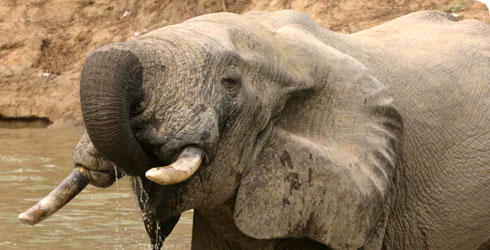Feeding ecology and diet
Food
Elephants consume a huge range of plant types, including grasses, herbs, shrubs, broadleaved trees, palms, and vines. Depending on the plant, they can take every conceivable part, including leaves, shoots, twigs, branches, bark, flowers, fruit, pods, roots, tubers and bulbs. The range of plants taken by an individual elephant can be anything between 100-500 species, although in a given time and place the animals may concentrate on a few species.
Seasonal
Patterns of consumption change with the seasons. In the savanna-woodland habitats of Africa, new-growth grasses are favoured in the rainy season, comprising 50-60% of the diet, but as these become tough in the dry season, the elephants switch to browse, so that the leaves and fruit of trees and shrubs now comprise 70% of the intake. For elephants in the rainforest habitats of Central Africa, the year-round supply of succulent leaves and fruits ensures that grass plays a lesser part in their diet.
Amount
Food consumption is 100-300 kg per day. Elephants spend 12-18 hours per day eating, most intensively in the morning and in the late afternoon to evening. In food-rich forest areas, elephants will typically move slowly through the day, browsing on a variety of plants, and eventually covering several kilometres. In many areas, there are daily rhythms: where both woodland and open grassland are available, for example, the elephants may spend the morning and early afternoon browsing in the woodland, emerging in the cool of the late afternoon to graze. Fluid consumption can be 200 litres of water per day in hot weather. When water is scarce, elephants will dig holes in dry stream or lake beds, using their feet, trunk, and tusks, until water seeps in and can be sucked up.
Area
When plants become ready at particular times of year, such as fruits or new shoots, elephants will gravitate towards them, using both smell and a memory from past years. Generally speaking, the poorer the quality, abundance, or predictability of food and water, the greater the distances elephants must travel to find it. Home ranges, measured by radio-collaring individuals, can be as high as 3000 km2 in the Namib desert, where individuals can easily walk 80 km in a day. In many areas, migrations are seasonal. Where water is a key issue, elephants tend to accumulate in the dry season in areas where it can be found, dispersing more widely when this constraint is lifted during the wet season.
Trunk
Small items can be plucked or picked up with the terminal ‘fingers’ of the trunk; larger items, such as branches, by curling the trunk around them and pulling or twisting. Elephants are highly inventive and can be seen, for example, kicking up sods of dry turf with their feet, picking up the resulting grassy clump with the trunk, banging it against their leg to shake off the earth, and putting it in their mouth. To reach high branches where young, succulent leaves are to be found, or high in acacia trees, where there are fewer thorns, they can rear up on their back legs, giving a total reach of up to 8 m. They will also uproot or push over trees. Finally, the trunk is important in drinking; water is not sucked all the way up into the nose like a drinking straw, but is sucked into the lower part of the trunk, then the trunk is arched and water squirted into the mouth. The only time in its life when an elephant feeds directly with its mouth is when suckling, the mouth being pressed directly against the breast with the trunk curled up out of the way.
Tusks
The tusks are used to strip bark from trees, which is then eaten; to dig for roots or for water in the dry season; and to scrape or hack salt and other minerals from the soil or exposed rock.
Teeth
The molar teeth display a series of long, thin, enamel ridges running side-by-side; for this reason, an elephant chews by swinging its lower jaw fore and aft, so that the enamel ridges on the upper and lower teeth cut past each other, shearing the food. The tremendous wear caused by feeding long hours every day on abrasive food causes the teeth to grind down to the root, and elephants not only have high-crowned teeth, but replace their teeth five times through their life, making six sets in all. Each set, however, comprises only four massive molars: lower and upper, left and right. As one tooth wears out it moves forward in the jaw and is gradually replaced by another from behind.
Digestion
The majority of an elephant’s digestion is accomplished with the aid of cellulose-digesting micro-organisms inhabiting its large intestine, especially a large blind sac opening from it, the caecum. This is a relatively inefficient method of digestion – only 40% or so of food, by weight, is utilised – but it does allow the animal to process large quantities of relatively low-nutrient food. The intestine is up to 35 m long and may weigh up to a tonne when full of food, releasing an average of 100 kg of dung per day.
Elephants seem quite resistant to the tannins present in, for example, acacia bark and, by consuming a wide variety of species, they limit the intake of toxic defensive compounds specific to particular plant types. Tree bark is eaten because it provides essential minerals and fatty acids, as well as roughage. Elephants also frequent salt licks, those patches of soil or exposed rock high in minerals such as sodium.
